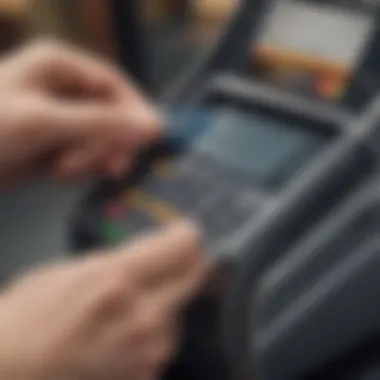Understanding Pay As You Go Cards: A Comprehensive Guide


Intro
In modern finance, pay as you go cards have gained traction as flexible and versatile money management tools. These cards are designed for individuals who prefer to have more control over their spending, allowing them to load funds onto a card and use it like a debit card, without the need for a traditional bank account. Given the complexity of financial options available today, understanding how these cards operate is key for young professionals, families, and students. This guide will delve into the essential aspects of pay as you go cards, making it easier for readers to decide if this financial product meets their needs.
Overview of Financial Product
Definition
Pay as you go cards, often referred to as prepaid cards, are financial instruments that allow users to load a specific amount of money that can be used until the balance is exhausted. Unlike credit cards, these cards do not involve borrowing; users spend only what they load onto the card.
Key Features
Some key features of pay as you go cards include:
- Prepaid Functionality: Users load money onto the card before any transactions can occur.
- No Overdraft Fees: Since they operate on a prepaid basis, users cannot exceed their balance.
- Wide Acceptance: These cards are generally accepted at most merchants that accept credit and debit cards.
- Reloadable: Many pay as you go cards can be reloaded with additional funds as needed.
Purpose and Benefits
The primary purpose of pay as you go cards is budgeting and convenience. They help users control their spending, making them ideal for those who may struggle with traditional credit systems. Benefits include:
- Enhanced Oversight: Users can monitor their spending closely since they can only use the funds they have loaded.
- Safety: Using a prepaid card can reduce the risks associated with carrying cash.
- Accessibility: Pay as you go cards do not usually require a credit check or bank account, making them accessible for a broader audience.
Types and Categories
Cards Types
There are several categories of pay as you go cards available:
- Retail Prepaid Cards: Often issued by retailers like Target or Walmart for shopping exclusively at their stores.
- General-purpose Reloadable Cards: Such as Green Dot or NetSpend, that can be used globally and are reloadable.
- Gift Cards: Usually limited to specific retailers, these cards are often given as gifts.
Pros and Cons
While pay as you go cards come with advantages, they also present some drawbacks:
Pros:
- No credit checks are needed for issuance.
- Help limit spending.
Cons:
- Fees can be associated when loading or using the card.
- Limited features compared to some credit or debit cards.
Situational Uses
- Budgeting Tool: Ideal for individuals wanting to manage their monthly expenses.
- Travel: Useful for travelers to use without incurring foreign transaction fees.
Application Process
Steps to Apply
Applying for pay as you go cards is generally straightforward:
- Choose Your Card: Select the type of prepaid card that best fits your needs.
- Visit a Retailer or Website: Either purchase in-store or apply online.
- Load Money: Fund the card to begin using it.
Eligibility Requirements
Most pay as you go cards do not have stringent eligibility requirements. Generally, you must be:
- At least 18 years old.
- Have a valid identification.
Documentation Needed
- Government-issued ID.
- Social Security number, sometimes.
Common Mistakes to Avoid
- Not reading the terms and conditions fully.
- Forgetting to keep track of the balance on the card.
Tips for Success
- Always know your balance before making purchases.
- Compare different card options to find one with lower fees.
Costs and Fees
Types of Fees Associated
Common fees may include:
- Activation Fees: Initial cost to set up the card.
- Reload Fees: Costs associated with adding money to the card.
Comparisons of Costs Across Options
Evaluating different pay as you go cards can reveal significant differences in fees. It is important to check each card's fee structure carefully to avoid surprises.
Pay as you go cards can offer a flexible solution for those who prioritize budgeting and financial control. However, awareness of associated costs is crucial for maintaining financial health.


Prelims to Pay As You Go Cards
Pay As You Go cards offer an intriguing method for managing money in today's financial landscape. They play a vital role for many individuals who seek control over their spending behavior. Understanding these cards demands attention to their basic principles, benefits, and considerations that accompany their use.
Definition and Basic Principles
Pay As You Go cards, often known as prepaid cards, fundamentally operate on a simple principle: users load money onto the card before making purchases. This concept helps mitigate the risk of overspending. Unlike credit cards, where a user borrows money and pays back with interest, a Pay As You Go card relies solely on the user-loaded funds. This encourages mindful spending and helps people stick to their budgets. Users generally can reload these cards as needed, providing both flexibility and versatility in managing personal finances.
Furthermore, these cards are accessible and can often be used wherever standard debit and credit cards are accepted. They allow for online shopping, in-store transactions, and some can even facilitate international purchases, making them suitable for various lifestyle needs.
Historical Context
The evolution of Pay As You Go cards traces back to the late 20th century, evolving from paper gift certificates and cash-based systems. Early models were primarily used for gifts, allowing recipients to spend at specific retailers. As shopping habits changed with the rise of online platforms, the emergence of digital payment methods became essential. The first prepaid debit cards gained popularity after the turn of the century, primarily within consumer markets. Financial institutions recognized the potential for offering customers a cash-less solution that addresses common issues like overdrafts and credit reliance.
Over the years, regulations also evolved. Governments instituted measures to protect consumers, ensuring proper handling of funds on these cards. Growing consumer awareness has led to an increase in demand, driving competition among providers. This push for innovation has resulted in the continued adaptation of Pay As You Go cards, which now includes integration with mobile wallets and advanced security features, supporting the needs of modern users.
Understanding this background offers insights into how these cards fit into our financial lives today, serving a diverse range of consumers from students to families.
Types of Pay As You Go Cards
Understanding the variety within pay as you go cards is essential for users aiming to identify the ideal option for their specific needs. Each type comes with its unique features and benefits that cater to different circumstances and preferences.
This section will illustrate the three main categories: prepaid debit cards, mobile wallet solutions, and gift cards. By examining these types, users can align their choice with financial habits and goals.
Prepaid Debit Cards
Prepaid debit cards are a prominent type of pay as you go card. Unlike traditional debit cards, they do not draw funds from a bank account but instead rely on preloaded money. Users load a specific amount onto the card before use. This format offers a controlled spending environment, allowing individuals to avoid overspending.
In practical terms, these cards are accessible to a majority of people, including those without a traditional banking setup. Many prepaid debit cards, such as the NetSpend Prepaid Card and the Bluebird by American Express, offer options for direct deposit and online transfers.
Moreover, prepaid debit cards simplify financial management, making them appealing to students, families, and young professionals.
They also serve well in situations where there's a need for budgeting, as the card's balance directly reflects the available funds.
Mobile Wallet Solutions
Mobile wallet solutions have emerged as a modern and convenient option for pay as you go transactions. These solutions, like PayPal, Venmo, or Apple Pay, allow users to store their card information and make payments directly from their mobile devices. This eliminates the need for physical cards while maintaining the pay-as-you-go format.
One significant advantage of mobile wallets is their integration with various online platforms and retailers. They offer quick access to funds and often do not require a bank account. This accessibility aligns well with younger demographics and tech-savvy users. Additionally, these solutions often boast enhanced security features, such as biometric authentication.
As mobile wallets advance, some are incorporating cryptocurrencies, further broadening their utility. Users can manage their finances efficiently and securely, making this an attractive proposition in the pay as you go landscape.
Gift Cards
Gift cards represent a specialized type of pay as you go card, often associated with brands or retailers. They allow users to preload a specific amount intended for shopping at a designated store. Fallout from a gift card purchase does not involve any additional fees unless noted by the retailer.
For many, gift cards serve as great options for gifting and providing flexibility in spending. They cover a range of items from fast food to online shopping at platforms like Amazon or iTunes. In this way, they can cater to diverse shopping habits and preferences.
However, it is essential to note that some gift cards may have expiry dates or fees related to inactivity, making it crucial to read terms and conditions before purchasing or using them.
Each of these types of pay as you go cards brings unique benefits and drawbacks. Understanding these distinctions can help consumers navigate their options effectively, ensuring they choose a method that aligns with their financial needs.
How Pay As You Go Cards Work
Understanding how pay as you go cards function is vital for leveraging their benefits while navigating the potential pitfalls. Dominantly, these cards operate on a relatively straightforward mechanism that begins with loading funds and ends with seamless transaction capabilities. Recognizing the fundamental aspects of their operation helps in making informed financial decisions. This section will explore loading funds, making transactions, and managing balances.
Loading Funds
Loading funds onto a pay as you go card typically involves transferring money from a bank account, a cash deposit, or through an online transfer. Users can generally load funds through various channels such as ATMs, retail locations, or directly via a linked bank account. Each method has its own set of conveniences and potential fees.
When you load a pay as you go card, it's crucial to keep track of the amount being loaded. This ensures you always know your remaining balance. For young professionals and families, this can help in budgeting effectively without the risk of overspending. Additionally, some cards allow for automatic reloading, offering a subtle peace of mind by ensuring you do not run out of funds inadvertently.
Making Transactions
Transactions made with pay as you go cards can mimic those performed with traditional debit or credit cards. When you make a purchase, the amount is deducted directly from your card balance. This encourages fiscal responsibility since users can only spend what they load onto the card.
Moreover, the transactions can be conducted in various settings including online markets, brick-and-mortar stores, or even while traveling abroad, depending on the global acceptance of the card type. Keep in mind, some cards may have restrictions on certain types of purchases while others might offer more versatility. Understanding these nuances is significant when choosing the right product for your needs.
Managing Balances
Management of balances in pay as you go cards requires a slightly different approach compared to traditional banking methods. Users should regularly check their card balance to ensure they do not exceed their limit. Many cards offer mobile applications or online portals that provide real-time access to account information.
Tracking expenditures can lead to improved budgeting skills. Some cards also provide spending reports or categorization of transactions, enhancing users' ability to analyze where their money goes every month. This transparency is invaluable, especially for families or students aiming to manage their finances efficiently.
Managing your balance is critical to avoid unexpected transaction declines or fees.
Overall, understanding the functioning of pay as you go cards provides a reliable foundation for handling your finances. By exploring how to load funds, make transactions, and manage balances effectively, users can maximize the benefits these cards offer.
Advantages of Pay As You Go Cards
The advantages associated with pay as you go cards are numerous and play a crucial role in their appeal. Understanding these benefits can assist individuals in making informed financial decisions. These cards, designed to facilitate a controlled spending environment, provide users with a clear view of their finances. Below are some of the significant advantages.
Budgeting Control
One of the most significant advantages of pay as you go cards is the ability to control budgeting effectively. Unlike traditional credit cards, which can lead to overspending due to available credit, pay as you go cards only allow transactions up to the loaded amount. This feature inherently encourages users to stick to their budget.
With a finite balance, individuals can prioritize their spending, thus aligning more closely with their financial goals. For example, a student on a tight budget can manage daily expenses or allocate funds for specific categories such as groceries or entertainment without the threat of accruing debt.
Setting a budget becomes a straightforward process, as users need only to load the amount they are willing to spend. Tracking expenses is more manageable because each transaction reduces the balance visibly. Clear visibility can lead to improved financial health, particularly for those who struggle with impulse purchases.
Reducing Overdraft Risks
Pay as you go cards mitigate the risks of overdrafting, a common pitfall for users of traditional bank accounts and credit cards. With a pay as you go structure, spending is bound by available funds. This design eliminates the potential for exceeding financial limits, which can often result in costly overdraft fees.
For many young professionals and families, avoiding unexpected fees is important for maintaining financial stability. These fees can accumulate quickly, leading to significant financial strain. Pay as you go cards enable users to avoid this issue by only permitting transactions within the loaded balance. Thus, users can feel more secure about their spending habits, knowing they cannot accidentally go into debt.
Accessibility for All Users


The accessibility of pay as you go cards is another noteworthy advantage. These cards are widely available and can be acquired with minimal fuss. Many financial institutions and retailers offer options without the need for stringent credit checks, making them an excellent choice for individuals with limited credit histories or those who prefer not to engage in lengthy application processes.
Furthermore, the simplicity of use allows a broad range of demographics to benefit. Students can easily manage their finances without the risks associated with credit cards. Families can control each family member’s spending by providing them with their own cards. This level of flexibility makes pay as you go cards an appealing choice for various users.
Pay as you go cards offer effective ways to manage finances without the anxiety of debt resulting from overspending.
In summary, the advantages of pay as you go cards include effective budgeting control, reduced risks of overdraft, and accessibility for a varied audience. These positive features contribute to their growing prominence within the financial landscape.
Potential Drawbacks
Understanding the potential drawbacks of pay as you go cards is critical for consumers. While they offer flexibility and control, certain limitations can affect their overall appeal and utility.
Limited Features Compared to Traditional Cards
Pay as you go cards often lack features that are standard in traditional credit or debit cards. For instance, pay as you go cards typically do not offer the same rewards programs, cashback options, or extensive customer service. Their simplicity can be both an advantage and a disadvantage, depending on user preferences. Users seeking to build credit will find this type of card unsuitable, as these cards do not contribute to credit history. Additionally, they usually do not provide overdraft protection, which could lead to a declined transaction or embarrassment at the point of sale.
Fees and Charges
Fees associated with pay as you go cards can deter potential users. It is important to understand these costs to make informed decisions.
Activation Fees
Activation fees are often charged when setting up a pay as you go card. This fee can vary widely, depending on the provider. While it is a common practice, it impacts the initial usability of the card. Sometimes, these fees can negate the advantages of having a no-frills payment solution. Users should examine the total costs carefully, as some providers may advertise low monthly fees but have high activation fees that make them less appealing overall.
Monthly Maintenance Fees
Monthly maintenance fees can apply to pay as you go cards. These fees are deductions made monthly just for having the card. This fee is significant because it can erode the balance faster than expected. For families or students who are budget-conscious, this can be an unexpected burden. It is essential to inquire about these fees upfront before choosing a provider.
Transaction Fees
Transaction fees may also apply when using pay as you go cards. Whether the card is used for in-store purchases or online transactions, these fees can accumulate. They vary from provider to provider, but they can significantly diminish the card's value as a cost-effective solution. Users must be vigilant and read the fine print, as these fees can substantially impact overall savings.
Understanding fees and drawbacks is essential for using pay as you go cards in a financially responsible manner.
Security Considerations
Understanding the security aspects of pay as you go cards is essential for users. These cards, although convenient, present unique vulnerabilities. Therefore, knowing how to protect oneself while using these financial tools is a critical element of this guide.
Fraud Protection
Fraud protection is a primary consideration when it comes to pay as you go cards. Many issuers of these cards employ various security features to combat unauthorized transactions. Features like transaction alerts can notify the user of any unusual activity quickly. Additionally, some cards offer the ability to freeze accounts through mobile applications.
Educating users on safe practices is crucial. Here are some general tips to enhance fraud protection:
- Regular Monitoring: Keep an eye on account activity. Frequent checks can help identify unauthorized charges.
- Secure Personal Information: Never share card details or personal information publicly. This includes social media.
- Use Secure Connections: Only access financial information on secure, trusted Wi-Fi networks.
These precautions may significantly reduce the risk of fraud while using pay as you go cards.
Handling Lost or Stolen Cards
Losing a pay as you go card or having it stolen can be distressing. However, knowing how to respond can alleviate some worries. Most card issuers have protocols in place for reporting lost or stolen cards. Users should familiarize themselves with these steps in advance.
If a card is lost or stolen, the following actions should be taken immediately:
- Contact the Issuer: Report the loss to the card issuer as soon as possible. The issuer can block the card and prevent further fraudulent use.
- Review Transactions: After reporting, check recent transactions for any unauthorized activity. This helps in reporting any fraud to the issuer.
- Follow Up on Replacement: Request a replacement card. Most companies will issue a new card, sometimes with a different number, usually within a few days.
Comparison with Other Payment Methods
Understanding how pay as you go cards stand compared to other payment methods is crucial for making informed financial decisions. Each payment method has its own set of features, advantages, and limitations. In this section, we focus on the distinctions and similarities between credit cards, debit cards, and pay as you go cards, addressing specific elements that young professionals, families, and students should consider when selecting their payment options. This analysis can help guide your financial strategies significantly.
Credit Cards vs.
Pay As You Go Cards
Credit cards are popular for their ability to offer credit limits, enabling consumers to make purchases beyond their available funds. They often come with rewards programs, such as cashback or travel points, which can be attractive for many users. However, credit cards also depend on responsible use to avoid high-interest debt.
In contrast, pay as you go cards require users to load funds before making transactions. This aspect promotes careful spending as users cannot spend more than what they have loaded. Additionally, pay as you go cards typically come without the risk of incurring debt, which can save users from financial stress.
Some key points of comparison include:
- Spending Limit: Credit cards offer a revolving line of credit, while pay as you go cards limit spending to the balance loaded.
- Fees and Charges: Credit cards may have annual fees and interest charges, whereas pay as you go often involve fewer fees but may charge for loading funds or monthly maintenance.
- Rewards Programs: Credit cards usually offer rewards for spending, while pay as you go cards focus more on simplicity without such rewards.
In summary, the decision between a credit card and a pay as you go card comes down to personal finance habits and needs. A credit card might be beneficial for someone who can manage debt responsibly, while a pay as you go card suits those wanting control over their spending.
Debit Cards vs.
Pay As You Go Cards
Debit cards serve as direct access to funds in a linked checking account. This method is similar to pay as you go cards, which also only allow spending the amount loaded. Both options eliminate the concern of incurring debt. However, they have notable differences.
One of the significant advantages of debit cards is their wider acceptance. Most retailers, both online and in-store, accept debit cards linked to major networks such as Visa or Mastercard. On the other hand, pay as you go cards may have limitations on where they can be used.
Consider the following comparisons:
- Accessibility: Debit cards are generally accepted globally, while pay as you go cards can have regional or merchant limitations.
- Management: Both offer ease of use and promote budgeting, but their management and loading processes differ.
- Linked Accounts: Debit cards draw directly from bank accounts, providing instant payment, while pay as you go cards require pre-loading, which might be less convenient in certain scenarios.


Choosing between debit cards and pay as you go cards depends on factors such as ease of use, acceptance, and personal banking habits.
Typical Use Cases
Understanding the typical use cases for pay as you go cards is crucial for grasping their practical applications and benefits. Each scenario provides insight into how these cards can serve various financial needs and preferences. This section highlights how pay as you go cards can be advantageous in traveling, daily purchases, and gifting situations.
Traveling
When traveling, managing expenses can be complicated. A pay as you go card offers a practical solution for these circumstances. Loading funds specifically for travel enables better control of expenditures without the risk of overspending. Additionally, many pay as you go cards are designed to work internationally, avoiding the need for multiple currencies. This can reduce conversion fees and confusion at foreign exchanges.
Using a card also enhances security. Carrying cash can be safer than having large amounts, but stealing a card can still happen. In case of loss or theft, reporting the incident swiftly can prevent unauthorized transactions. Understanding that you can only spend what you have loaded can help with budgeting on the go.
Everyday Purchases
In daily life, pay as you go cards provide an accessible and straightforward alternative to traditional banking methods. They allow for easy purchases without relying on credit, which can lead to debt. Families, students, and young professionals can benefit significantly from setting budgets using these cards.
Moreover, merchants increasingly accept these cards, making them convenient for various purchases such as groceries, clothing, or entertainment. When budgeting, a card creates a financial discipline. It limits spending to the existing balance, ideal for those trying to manage their finances better. Moreover, because users can load only what they need for a given period, it simplifies household budgeting.
Gifting and Giving
Pay as you go cards are increasingly popular as gifts. They offer flexibility for recipients, allowing them to choose what to purchase rather than limiting them to a single item. You can give someone a prepaid gift card for various retailers, which can be a thoughtful choice for birthdays or holidays.
Additionally, these cards can serve as a practical gift for students heading off to college or young professionals just starting their careers. Giving them a pay as you go card ensures they have access to funds without the potential pitfalls of direct cash. The recipient can use them responsibly, which might inspire better financial habits.
Using pay as you go cards for gifts combines practicality with thoughtfulness, making them a fitting choice for many occasions.
Regulatory Aspects
Regulatory aspects of pay as you go cards play a crucial role in ensuring consumer safety and maintaining fair practices in the financial sector. These regulations are in place to provide a framework that protects users from potential abuses and fraud. Understanding these components is essential for anyone considering the use of a pay as you go card.
Consumer Protection Laws
Consumer protection laws are designed to safeguard individuals from unfair treatment in the marketplace. These laws cover various aspects of pay as you go cards, ensuring that users have clear information about fees, usage limits, and other critical details. Regulations often dictate that issuing companies must disclose the terms of service in a transparent manner. Failure to comply can result in penalties or even increased scrutiny from regulatory bodies.
Additionally, many countries have established specific rights for consumers using these cards. For example, users might be entitled to refunds or assistance in cases of fraudulent activity or incorrect charges. These rights empower consumers to feel more secure as they navigate transactions with their pay as you go cards.
Regulatory frameworks adjust over time to match changing market conditions, aiming to enhance user protection.
Compliance Regulations
Compliance regulations are essential in maintaining the integrity and security of financial systems. They require companies offering pay as you go cards to adhere to established guidelines and standards set by governing bodies. Typically, these regulations cover areas such as anti-money laundering efforts, data privacy, and transaction monitoring.
Companies must also conduct regular audits to ensure compliance and avoid hefty fines. This oversight not only protects users but also enhances trust in the financial services provided. For consumers, knowing that their card providers are subject to robust compliance measures can encourage the use of these cards.
In summary, understanding regulatory aspects is an important undertaking for users of pay as you go cards. Familiarity with consumer protection and compliance regulations can guide individuals in making informed choices. It helps in recognizing their rights and understanding the responsibilities of card issuers.
Future Trends in Pay As You Go Cards
Understanding the future trends in pay as you go cards is crucial for consumers and industry stakeholders alike. As the financial landscape evolves, these cards are adapting to meet consumer needs. Technological advancements and market shifts are shaping the way these cards operate.
Technological Innovations
Technological innovations are driving the future of pay as you go cards. Digital banking and mobile payment solutions are becoming increasingly prevalent. Consumers can now load funds and manage their cards through smartphone applications. Apps offering real-time notifications can help users track their spending and maintain control over budgets. Additionally, some prepaid card providers now incorporate features like virtual cards for online transactions, enhancing security and user convenience.
These innovations also extend to security. Enhanced encryption and tokenization methods are being utilized to protect user data. Moreover, biometric authentication is gaining traction, offering an alternative to traditional PINs. This is especially relevant in an age where data breaches are a growing concern.
Incorporating technologies like blockchain could also revolutionize how transactions are processed. Enhanced transparency and reduced costs could be achieved, creating a safer environment for users.
Market Projections
Market projections indicate a growing acceptance of pay as you go cards across various segments. Younger consumers, particularly millennials and Gen Z, are increasingly turning to these options for financial flexibility. This demographic values budget control and convenience, making them prime candidates for pay as you go solutions.
Analysts predict that the global prepaid card market will continue to grow significantly in the coming years. This growth will likely be fueled by increased vendor acceptance and the expansion of payment processing networks. Moreover, as e-commerce continues to rise, the demand for easy-to-use payment methods, including digital wallets and prepaid cards, is expected to surge.
As regulatory frameworks evolve, the dynamics of the market will change. Financial institutions are also likely to adapt their offerings to remain competitive. Overall, the future of pay as you go cards appears promising, aligning well with consumer preferences and technological advancements.
The financial landscape is rapidly changing, and pay as you go cards are at the forefront of this transformation, adapting to meet user needs and expectations.
Epilogue
Understanding the impact and functionalities of pay as you go cards is essential in today's financial landscape. This article sheds light on several key elements of these cards that cater specifically to the needs of young professionals, families, and students. From their budgeting capabilities to their convenience, recognizing the advantages these cards offer is vital for making informed financial decisions.
In summary, we have highlighted that pay as you go cards provide users with greater control over their spending habits. They serve as an effective tool for those looking to avoid debt accumulation, owing to their inherent limitation on available funds. Moreover, the accessibility of these cards supports a diverse user base, allowing individuals who might not qualify for traditional banking products to still engage in financial transactions.
The use of pay as you go cards is a practical solution for those aiming to enhance financial literacy and management.
However, it is equally important to consider the potential drawbacks associated with these payment methods. Fees, limited features, and lack of certain consumer protections can hinder the overall user experience. Thus, a balanced perspective is recommended when evaluating the utility of pay as you go cards.
This comprehensive examination encourages readers to weigh the pros and cons while considering how these cards align with their personal financial situations and goals.
Recap of Key Points
- Functional Clarity: Pay as you go cards allow individuals to load funds easily and make transactions without incurring debt.
- Budgeting Control: These cards foster better spending habits by limiting potential overspending.
- Accessibility: They are available to users who might not qualify for traditional credit options, expanding financial participation.
- Drawbacks: Users should be aware of potential fees and limitations compared to credit and debit cards.
Final Thoughts
In closing, as the financial landscape evolves, pay as you go cards offer a flexible option suited for various demographic needs. The examination provided here underscores their relevance and importance in assisting individuals to manage their finances efficiently.
While these cards are advantageous in many respects, being vigilant about associated fees and limitations is crucial. Making an informed decision regarding their use can lead to improved financial functionality, contributing positively to overall financial well-being.
With ongoing technological advancements, these cards are likely to evolve and integrate further features, potentially enhancing their utility and appeal. It will be interesting to observe how these developments unfold and whether they can address the present concerns users may hold.



